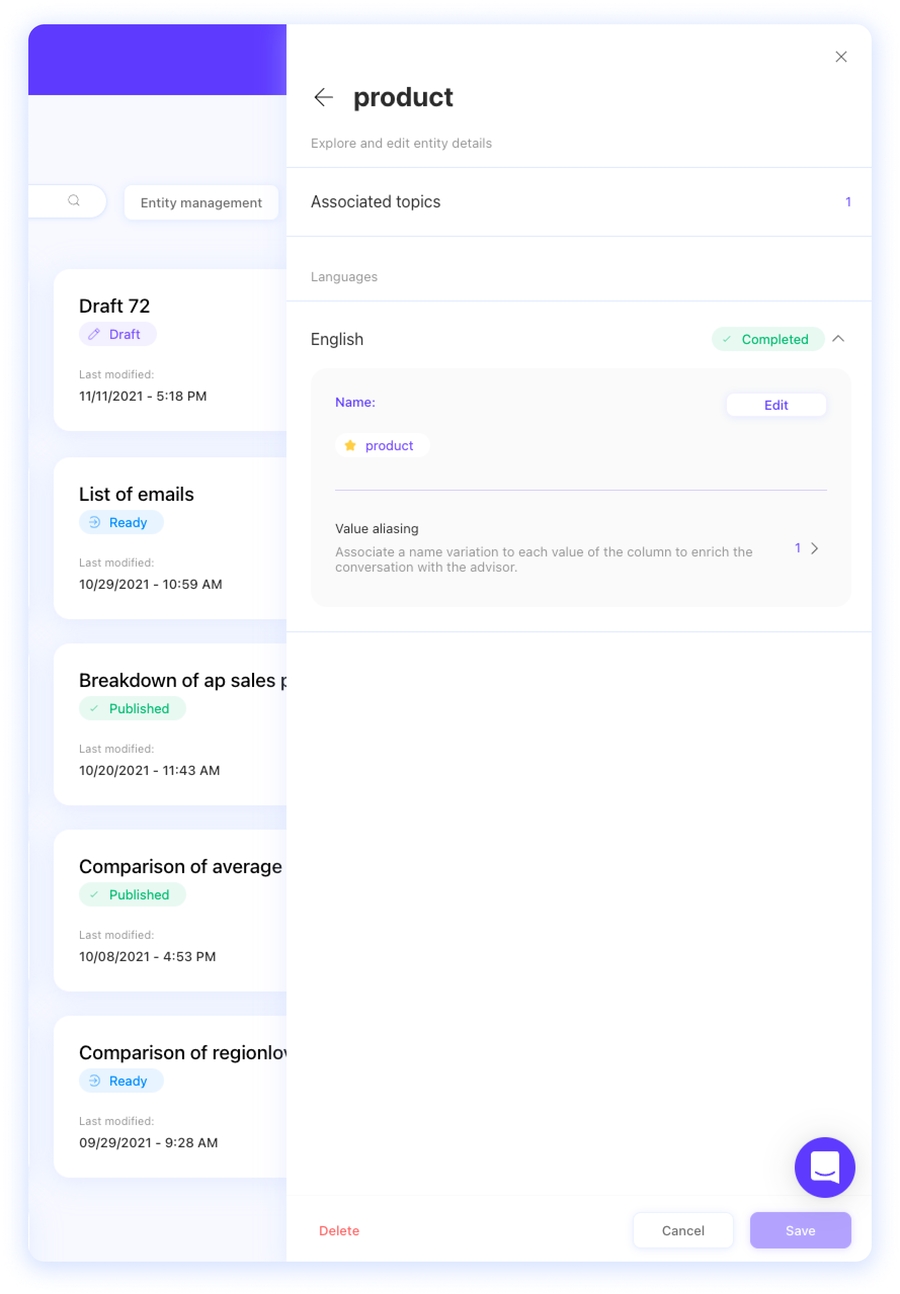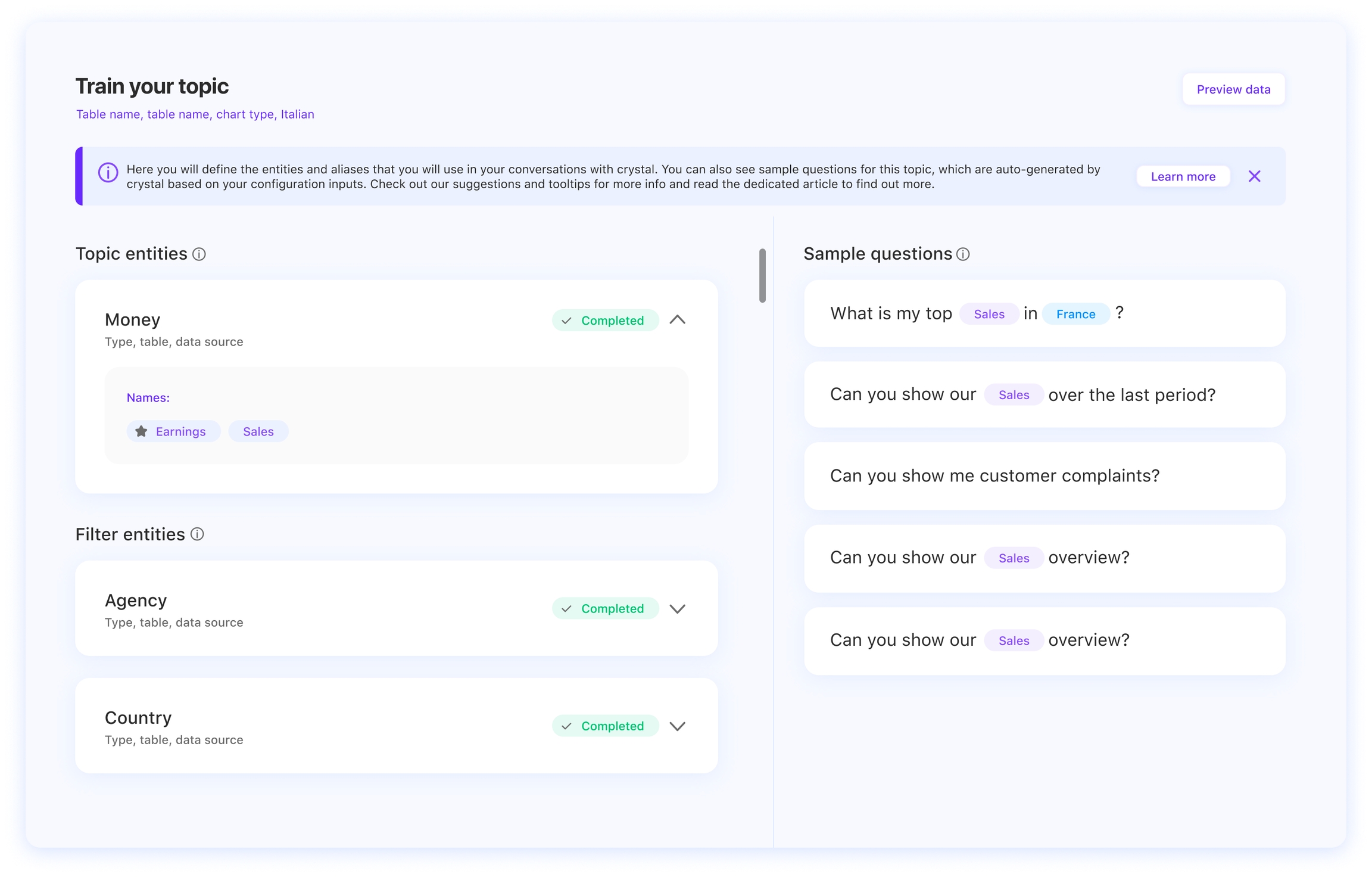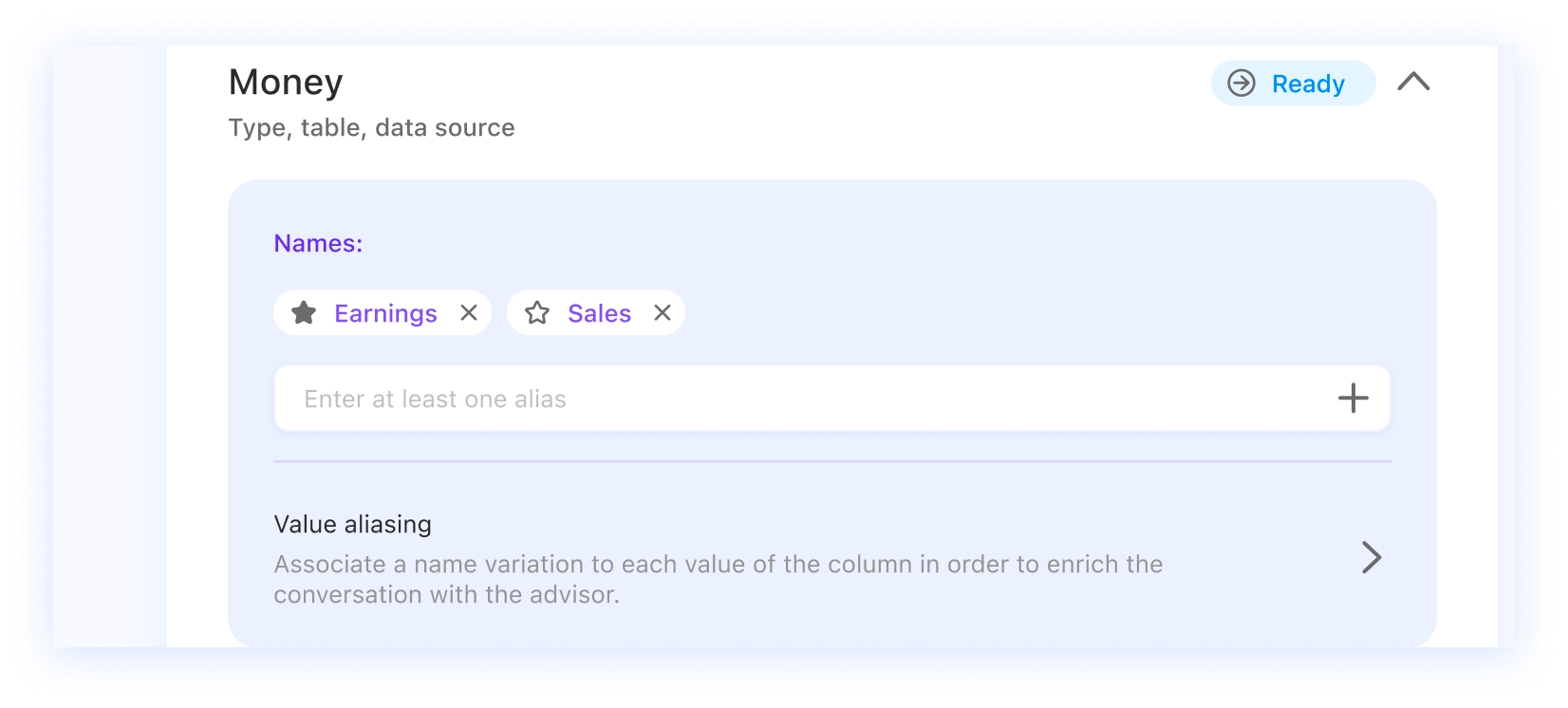Topic Creation: Train
This page is currently under review. Stay tuned!
crystal provides insights through topics. Building your topics is the core of the Self-Service Console. The topic creation flow is made of four main steps:
Train
The train step is the last of four steps in the topic creation flow and it is crucial to helping crystal understand the conversation elements and address the user requests to produce valuable results and answers.
In this stage, if not already done, it is very important to choose the right entity aliases to make sure that all users can solicit the correct topic, even if different words are used. Through the training process, crystal integrates the topic’s objective, data and associated names into a conversation that is understandable and accessible for all users.
Let’s see how it works.
The train step
In this step, you can set aliases for specific columns and see the questions that you can ask the advisor during the conversation. The alias represents the name of a specific column that you can use in the advisor to ask a question for that specific data.

In the Topic entities section you will have the opportunity to assign name variations to your topics.
In the Filter entities section you can add filters to get more detailed insights out of your topic.

When you reach the train step, after connecting, configuring and filtering your topic, you might encounter two scenarios:
If the column you are creating the alias for has not already been used in another topic, the system will ask you to enter at least one name variation (the alias) for each topic and filter entity.

2. If it has been used, you will not be able to modify it here. You will have to change it from the entity management view, which you can reach from the main page of the Self-Service Console.

When you set at least one name variation, the entity’s status changes from to-do to ready. Once all topics and filter entities show the completed status, it means that you're ready to proceed with the topic creation.

The first name variation will be automatically marked as primary. The primary name variation represents the main name that crystal will use to refer to that entity.
If it is a topic entity, it will be used to generate the topic title that you will see in the topic management view.
You have to set at least one name variation for each topic and filter entities selected for the topic you're gonna create.
For each name variation you add, you will see in the right area of the page, called sample questions, the questions generated based on the names added. These questions are generated in real time and represent the questions you, or your colleague, can ask the advisor once the topic is published, to retrieve the information related.
You can see inside the questions the purple element that represents exactly the name variations you set for the column, and the blue element that shows you the variable part of the question based on the value of the filter used in the topic. When you’ll ask this topic in the advisor you’ll be able to ask for different filter values for this topic. (E.g. What’s my top sales in France?)
What is the value aliasing?
The value aliasing allows you to associate a specific alias for each value of the column. For example, it could be very helpful to assign aliases to column’s values when you have numerical codes that can be hard to ask in the advisor.
E.g. In the Agencies column you could have the code IT0123 that refers to an agency in Milan: in this case you can set Milano as the alias for the value IT0123.
Bear in mind that value aliases do not replace the raw data in a column: they just make it easier for you to ask data to the advisor.

The train step: behind the scenes
Until now, we saw how the training process works from the user’s side.
But what happens in the system to let crystal understand what goes on in the conversation?
The process of retraining through which crystal updates and improves her capability to understand the conversation, is based on the following steps:
NLP (Natural Language Processing) datasets generation based on NLP classifiers.
Retrain request management and running.
Topic status transition management
Let’s see in detail.
NLP classifiers and how they work
NLP classifiers represent the core of crystal's intelligence capabilities.
Each classifier is specialized in detecting and understanding specific aspects of the conversation with the user.
crystal relies on multiple AI classification models, to interpret all the different users’ requests or conversational inputs, from chit-chat interactions to specific references to topics and alerts.
Classifiers are orchestrated by a coordinator, which is responsible for manipulating their classifications to distinguish the kind of request, the applied filters and the subject asked by the user.
To understand the interactions happening during the conversation and address the users’ questions with valuable information, classifiers need to learn about every aspect featured in the topics configured by the user, referring to:
possible questions the user could ask crystal to request a topic, including alerts and contextual expressions;
topic-specific data, such as entities and filters, topic title, etc.
Train and retrain crystal through publishing and unpublishing topics
To make crystal understand the content of conversation and all the questions you are asking, you should make sure that all relevant topics are set up and published.
To eliminate entities or topics which you don’t need anymore, you can always unpublish and delete them. Moreover, once you find a way to improve or edit your topics, you can always retrain crystal.
Let’s see how.
Publish topics
Once you have finished configuring your topic and setting up its related user permissions, you need to publish the topic in order to make it available to the advisor.
Topic publishing requests trigger a training process which allows crystal to recognize topics within the conversation. This is achieved by training the classifiers to detect the topic details within the text.
Unpublish topics
If you want to edit a topic configuration, or a topic is simply not needed and you don’t want crystal to recognize it anymore, you can unpublish the topic.
This action marks a specific topic as no longer retrievable, meaning crystal won’t identify that particular topic within the conversation. After you unpublish a topic, you can delete an entity and all the topics using that entity will become obsolete and will return back to the draft status.
The unpublishing process is then triggered for all the published topics associated with this entity, to make crystal aware of these changes.
Retrain crystal
To retrain crystal you can:
change the aliases related to that entity’s name;
add a new alias by typing a new value in the related bar;
change the main alias by clicking on the star icon of another alias;
remove an alias by clicking on the X.

We hope this article helped you out! Check the Topics section of our Resources to know more on topics creation.
Last updated
Was this helpful?